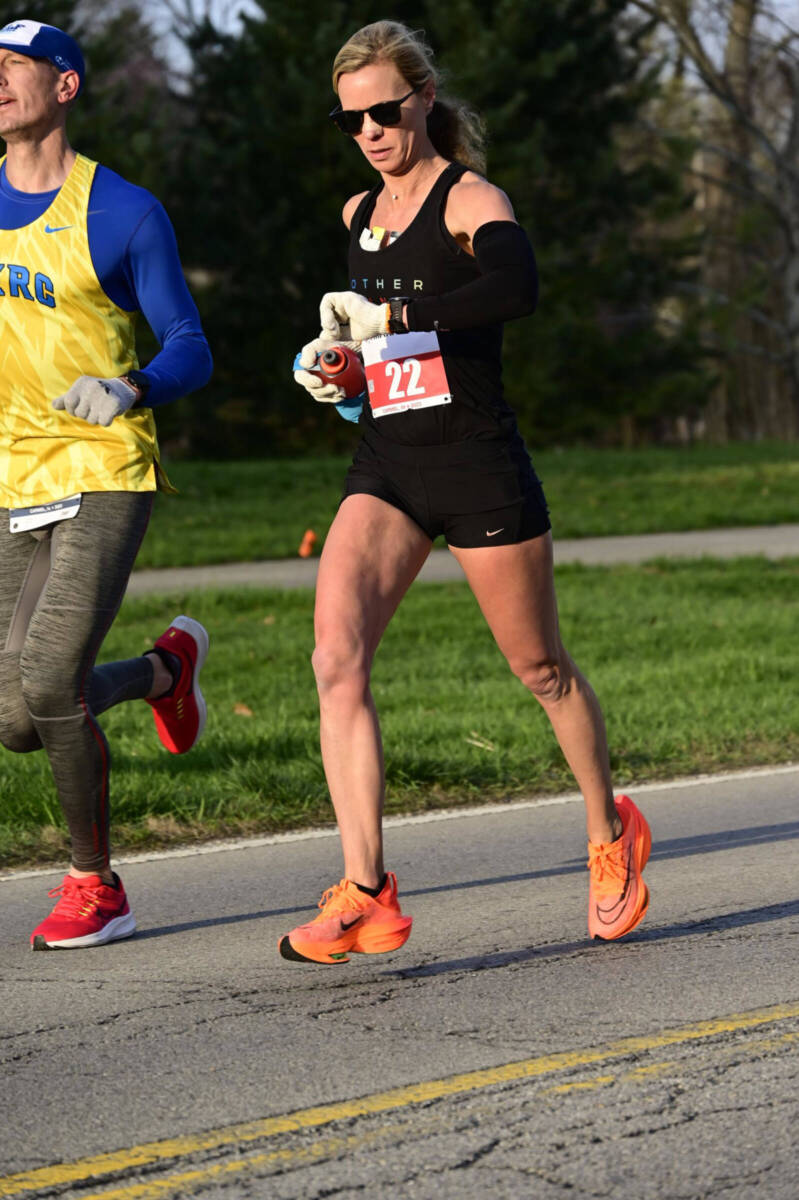Train Your Gut to Stop Runner’s Trots & Cramps
You can train your gut to minimize runner’s trots and tummy troubles during the marathon. They key is to practice fueling on your long runs, aiming to take in an energy gel every half hour, and fluids about every mile. Learn how.

Being a runner has many wonderful side effects but one of them is NOT runner’s trots —diarrhea and GI distress that endurance runners experience when going the distance. In fact, GI distress and running almost go hand in hand. I mean, it’s no coincidence that “runs” is a double entendre. “My long runs give me long runs…” You get the picture.
But new science in runner’s nutrition has unlocked a new fueling strategy called gut training for runners to stop runners trots (also known as runner stomach, runners cramps, runners diarrhea). Gut training involves teaching your stomach to tolerate carbohydrates during exercise. In addition to stopping runners trots, it can also stop “bonking” or hitting the proverbial wall in a marathon which is when your body runs out of carbs that covert quickly to energy.
It is something I have my athletes I coach prioritize with every training cycle because I have experienced firsthand the consequences of not training your gut properly for a race.
My first experience with runner’s trots
I felt great during the marathon until I hit the wall (aka bonking) when my stomach started cramping…bad. I was able to jog-walk to the finish and get my goal time of a Boston-Qualifying 3:29. Then it was straight to the bathroom. Repeatedly. I remember meeting my parents and boyfriend for a celebratory meal afterward, only to spend the whole time in the bathroom.
10 Tips for Training Your Gut for Athletic Performance
To prime you for all the gut training knowledge nutrition coach Dana Eshelman shares 10 key takeaways for training your gut to avoid runner GI distress:
- Train your gut to learn how to digest carbs and drinks during training at least 2-3 weeks before your event.
- Aim to consume roughly 60 grams of carbs per hour of your training and/or race.
- Switch up your carb source so that some have fructose and some have glucose. But do not mix sports drinks with gels in a single serving.
- Avoid foods high in fiber, fat, and protein before and during running.
- Monitor your diet by keeping a food journal 2-3 days before your long runs to learn what could be causing GI distress.
- Eat foods high in simple carbs before endurance running events and races like white rice, white potatoes, white pasta, and bananas.
- Avoid medicating to eliminate GI distress during runs.
- Stay hydrated before, during, and after your long run or race.
- Eat on a regular schedule, particularly before big runs or races.
- Practice your race-day nutrition on your long runs.
How to Train Your Gut for Running
The Academy of Nutrition and Dietetics recommends 30-60 grams of carbohydrate per hour of exercise and up to 90 grams of carbohydrate for endurance events lasting longer than three hours.
If you are someone that trains fasted, or not eating anything pre-workout, starting off consuming 30-60 grams of carbohydrate before or during a workout may seem overwhelming and will likely cause GI distress. Therefore, it’s important to start small, says Eshelman:
- Begin with what you can tolerate (likely 30 grams per hour)
- Gradually, increase the amount and frequency of your fueling on your long runs, e.g. a gel every 45 minutes, then increase frequency every 5 minutes. (Learn how to pick the right energy gel for you.)
- Aim for a gel every 30 minutes on race day.
Pay attention to how you feel as depending on the duration of your workout, you may need more or less carbs.
- Research suggests for running 1-2 hours, aim for 30 grams an hour.
- For running 2-3 hours, aim for 60 grams per hour. For running more than 3 hours, aim for 90 grams of carbs per hour along with 20 grams of protein in 5-7 increments.
- Changing up your carb source has also been shown to improve performance as it triggers different receptors in the body, allowing for improved oxidation rates.
How to Get Started Training Your Gut
Eshelman advises starting gut training by evaluating your current hydration and fueling plan. Pick one area to target and build from there. Try a small snack pre-workout, determine if that is enough or too much, adjust the timing of fueling and hydration, and continue to tweak based on energy, tolerance, and workout goals.
For workouts longer than one hour, add in hydration and fuel from the “Start Here” column below and decide if this is appropriate for your performance goals. Your fueling and hydration plan should be individual to you, and it often takes time to figure out your secret potion.
“Keep in mind, just like training, not all days are treated equally; your fuel and hydration needs will vary from day-to-day. Adequate training of the gut with both carbohydrate and hydration leads to a less dramatic decrease of blood flow with increased exercise intensities, which is important in preventing GI symptoms,” she explains.
If after taking these steps, you are chronically experiencing GI distress with increasing training duration and intensity, you may consider consulting a sports dietitian to find your optimal fueling and hydration technique.
Gut training fueling technique examples:
| Start Here | Making Progress | Goal Nutrition + Hydration | |
| Pre-workout
1-4 g/kg carbs in the 1-4 hours before exercise |
1⁄2 piece of fruit + 1 T nut butter + 12- 16 ounces water
OR 1⁄2 slice toast + 1 jam + 1 T nut butter + 12- 16 ounces water 12-15 grams carbs |
1 piece of fruit + 1 T nut butter + 12- 16 ounces water
OR 1 slice toast + 1 T honey + 1 T nut butter + 12- 16 ounces water 25- 30 grams carbs |
1 piece of fruit + 1 T nut butter + 1 T honey + 1 slice toast + 12- 16 ounces water
50-60 grams carbs |
| During workout
30-60 g carb/ hour of exercise lasting longer than 1 hour |
1-2 sports gummies OR
1⁄2 scoop drink mix in 32 ounces water 7-10 grams carbs |
3 sports gummies OR
1 scoop drink mix in 32 ounces water 20- 25 grams carbs |
6 sports gummies OR 2 scoops drink mix in 32 ounces water OR 3 sports gummies + 1 scoop drink mix in 32 ounces water45-60 grams carbs |
In the pre-workout phase, you want to focus on adequate carbohydrates and low to moderate fiber, fat, and protein foods. Carbohydrates are important for adequately fueling your muscles and topping off your energy stores, especially in workouts lasting longer than an hour. Fiber, fat, and protein will slow down digestion, which we want to avoid pre-workout.
Learn more about marathon fueling here.
Examples of a Runner’s Marathon Fueling Plan
These components should be consumed in meals and snacks throughout the day.
Pre-workout examples to work toward with 1- 4 hours before:
- 1 banana + 1 T nut butter (25 grams carb)
- 1⁄2 c oats + 1⁄4 c dried fruit (55 grams carb)
- 1 pita pocket + 2 T hummus (26 grams carb)
- Small sweet potato + 1/4 c Greek yogurt (20 grams carb)
- Bob’s oat bar (28 grams carb)
- 1 c honey bunches of oats + almond milk (47 grams carb)
- Dave’s Bread + 1 banana + 1 tsp honey (54 grams carb)
Pre-workout examples to work toward with 15-45 minutes before:
- 1⁄4 c dried fruit (20 grams carb)
- 6 oz real fruit juice or sports drink (20-25 grams carb)
- 1 c fruit smoothie (20-25 grams carb)
- Honey packet (15 grams carb)
During your workouts longer than 1-hour examples to work toward:
**remember staying hydrated decreases GI distress
- 1 scoop drink mix + 32 ounces water such as Skratch, Maurten, Nuun Endurance or Tailwind (20-25 grams carb)
- 2 scoop drink mix + 32 ounces water (40-50 grams carb)
- 6 energy chews such as Honey Stinger, ProBar Bolt, or Skratch (~45 grams carb)
- 1 energy gel such as Untapped, Honey Stinger, Maurten, or GU (20-25 grams carb)
FAQs about Gut Training & Runner’s Trots
What is gut training?
“If you have had a poor experience (or many missed attempts) at fueling during exercise, you are not the odd one out. This is common. As the research shows, the body is adaptable and by practicing a fueling and hydration plan, you can improve your carbohydrate tolerance over time,” says Eshelman.
Why do runners get diarrhea after a long run or other tummy troubles?
Digestion normally occurs at rest when there is adequate blood flow to the gut allowing for the absorption of nutrients and secretion of digestive enzymes, explains Eshelman.
Exercise causes stress on the body and a shift in blood flow away from the gut causing changes in GI motility, absorption of nutrients, and secretion of enzymes that aid in digestion. This causes malabsorption and causes a poor appetite, leading the athlete to not intake much-needed hydration or fuel (like me during my last couple of marathons).
Unfortunately, under-fueling and dehydration can cause additional GI distress and GI distress may be exacerbated by the intake of fuel and fluids during exercise. This leaves the endurance runner between a rock and a hard place. But don’t lose hope!
“In order for an athlete to tolerate more hydration and fuel to support performance and prevent GI dysfunction, they must train their gut!” she explains.
Why should a runner train their gut?
Lots of research shows that consuming carbs during exercise helps maintain intensity and delay the onset time of exhaustion, especially at higher intensity. Research shows the gut is highly adaptable and can accommodate changes in fueling through gene expression induced by sugar consumption. How cool is that? And, it doesn’t take a long time to do this.
The evidence indicates there is a two-to-three-week period of increasing carbohydrate intake during exercise to allow for adequate fueling and improved GI tolerance.
But, just as you wouldn’t run in new shoes for the first time on race day, it’s important you do a dress rehearsal for your fueling technique before race day. “Your hydration plan is also of significant importance as this can help control GI distress and dehydration may exacerbate stress on the gut,” Eshelman reminds us.
Have you had tummy issues ruin your marathon?






